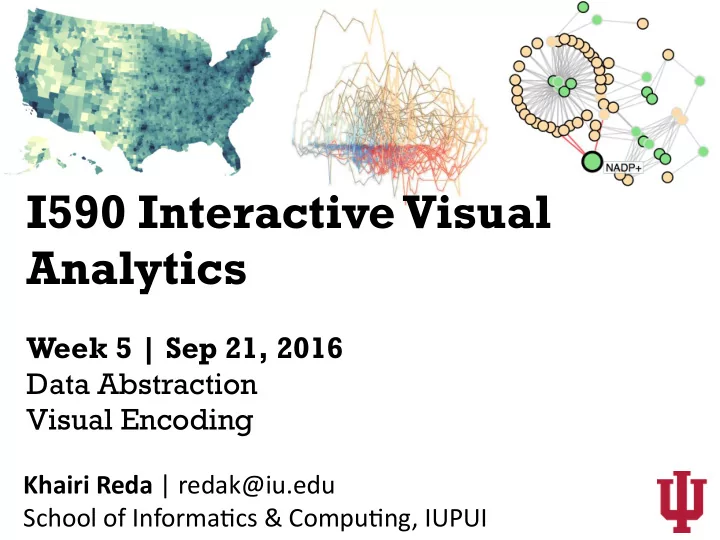

I590 Interactive Visual Analytics Week 5 | Sep 21, 2016 Data Abstraction Visual Encoding Khairi Reda | redak@iu.edu School of Informa5cs & Compu5ng, IUPUI
Project 1 Due Tuesday, Sep 27 at 8:59 PM Turn in as online web pages: Video with Interac>ve, live Design narra>on visualiza>on Document
Last 2 weeks
C. Ware Visual Thinking for Design
Cones, Rods, Color vision HyperPhysics, Georgia State University Wandell, “Foundations of Vision”
Simultaneous contrast Via Colin Ware
Simultaneous contrast Wong 2010 Via Miriah Meyer
POPOUT
Last 2 weeks Visual percep>on Our visual system sees differences, not absolute values, and is aGracted to edges. We can easily see objects that are different in color and shape, or that are in mo5on (popouts) Use color and shape sparingly to make the important informa5on pop out
This week • Data abstrac>on • Datasets: Tables, Networks, Fields, Geometry. • Variable types: Categorical, Ordinal, and Quan5ta5ve variables • Visual encoding • Marks and channels • Perceptual accuracy of channels
Data abstraction Transla5on of domain-specific terms into words that are as generic as possible type vs. seman>cs
Terminology Data Type fundamental units Dataset Type collections of units
Data Types • Items: are individual units of data. For example: rows in a table, points on a 5meline, nodes, … • AKribute: a property rela5ng to items, links, or posi5ons • Link: linkage between (typically) two items • Posi>on: designa5on of a point or a sub-space in a larger spa5al context • Grids: par55oning of space into typically uniform cells
Dataset Types
Flat Tables Key: Order ID Via Miriah Meyer
Multidimensional Tables Alex Lex
Visualizing Tables Example Parallel Coordinates
Dataset Types
Network / Graph items = people links = friendship
Network / Graph Wikipedia Node-link diagram Matrix Mike Bostock
Hierarchy/ Tree items = states links = winning paths
Hierarchy/ Tree items = species links = evolu5onary ancestry http://orig00.deviantart.net/7534/f/2008/105/2/0/2027d31d532a91b7324f30af187e0819.png
Hierarchy/ Tree items = zip codes links = containment http://orig00.deviantart.net/7534/f/2008/105/2/0/2027d31d532a91b7324f30af187e0819.png
Dataset Types
Grid attributes position population temperature density
Fields Scalar fields aKribute = one value examples: temperature, eleva5on Vector fields aKribute = vector (direc>on) wind map
Fields Scalar + Vector fields
Fields Scalar fields aKribute = one (real) value examples: one MRI scan slice (5ssue density)
3D Fields Based on a slide by Miriah Meyer
3D Fields Based on a slide by Miriah Meyer grid = MRI scan slices aGributes = 5ssue density
Visualizing 3D Fields Volume Rendering opacity tissue density http://www.fovia.com/gallery/medical/mg_bs.jpg http://www.dirkreiners.com/images/Research/tooth_tf.jpg
Grid Types Uniform Grids Geometry & topology can be computed Rec>linear Grid Nonuniform sampling Structured Grid Unstructured Grid More flexibility, store posi5on and connec5on Wikipedia Slide by Alex Lex
Dataset Types
Geometry World Atlas
Geometry http://farbackoutdoors.com/1593-2/
Geometry
Dataset Types
Sets
Clusters Dynamic (5me varying) Sta5c clusters clusters
Lists LineUp Baseball salary vs. performance Ben Fry
Attribute/Variable Types ✦ Categorical (Nominal, Qualita>ve) A finite set of categories No implicit ordering between categories ✦ Ordered •Ordinal Implicit ordering between categories/levels, but no clear magnitude difference. Can compare and determine greater/less than •Quan>ta>ve Meaningful magnitude Can do arithme5c
Quan>ta>ve Data Interval vs. Ordinal ✦ Interval •Zero does not indicate an absence of detectable measurement •We can determine distance between measurement, but not propor5ons •Example: temperature, dates ✦ Ra>o •The posi5on of zero indicates there is nothing of the measured en5ty •Can determine ra5o and propor5ons •Example: weight, age
Derived Data f(x) + g(x)
Quiz What aGribute/variable type (Categorical, Ordinal, Interval, or Ra5o) best fit the following measurements? •Speed •Facebook reac5ons (Like, Angry, Sad, etc…) •Car configura5ons (Compact, Mid-Sedan, SUV) •Product Name •IQ scores •College Majors •50-meter race 5me Based on a slide by Alex Lex
Another way to think about Ordered aKributes • Sequen5al temperature eleva5on (above/ • Diverging below sea level) • Cyclic 5me
Colormap categorical sequential discrete vs. vs. vs. ordered diverging continuous Match colormap to data type & task
Color design tools Helpful to match variable/aGribute type to colormap Color Brewer HCL Picker
Project 1 Q&A
Recommend
More recommend